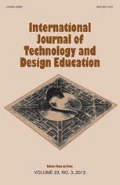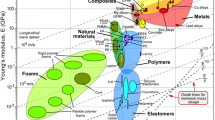Abstract
Product material choices affect how a product will be manufactured, how it will function, and how it will be experienced. Thus, understanding materials is essential for designers in many regards. However, materials used in designs are subject to ongoing changes in availability, processing methods, price and attributed meanings. Furthermore, new materials are constantly being developed. Therefore, designers continuously need to acquire new materials knowledge (i.e., internalisation of facts, information, and skills) to be able to produce designs that utilise available material possibilities and achieve the desired user experiences. However, although this topic has been dealt with to some extent, a detailed classification of approaches for how designers can acquire materials knowledge is absent in the literature. To provide designers and design educators with a structured basis for understanding/teaching materials knowledge acquisition, this paper develops a framework that defines twelve distinct ways for designers to acquire materials knowledge.



Similar content being viewed by others
References
Ashby, M. F., & Johnson, K. (2002). Materials and design: The art and science of materials selection in product design. Oxford: Butterworth Heinemann.
Ashby, M., & Johnson, K. (2003). The art of materials selection. Materials Today, 6(2), 24–35.
Ashby, M., Shercliff, H., & Cebon, D. (2007). Materials: Engineering, science, processing and design. Oxford: Elsevier.
Bligh, D. A. (2000). What’s the use of lectures?. San Francisco: Jossey Bass.
Bonwell, C. C., & Eison, J. A. (1991). Active learning: Creating excitement in the classroom. Washington, DC: School of Education and Human Development, George Washington University.
Cardello, A., & Wise, P. (2008). Taste, smell and chemethesis in product experience. In H. Schifferstein & P. Hekkert (Eds.), Product experience (pp. 91–121). Amsterdam: Elsevier.
Coorey, J. (2016). Active learning methods and technology: Strategies for design education. International Journal of Art & Design Education, 35(3), 337–347.
Cornish, H. (1987). Materials and the designer. Cambridge: Cambridge University Press.
Denzin, N. (2006). Sociological methods: A sourcebook (5th ed.). Chicago: Aldine Transaction.
Doordan, D. P. (2003). On materials. Design Issues, 19(4), 3–8.
Fenko, A., Schifferstein, H., & Hekkert, P. (2007). Shifts in sensory dominance between various stages of user-product interactions. Applied Ergonomics, 41(1), 34–40.
Ferrante, M., Santos, S., & de Castro, J. (2000). Materials selection as an interdisciplinary technical activity: Basic methodology and case studies. Materials Research, 3(2), 1–9.
Gibson, J. (1979). The ecological approach to visual perception. London: Lawrence Erlbaum Associates.
Griffiths, S., Houston, K., & Lazenbatt, A. (1995). Peer tutoring: Enhancing student learning through peer tutoring in higher education. Coleraine: University of Ulster.
Harvey, R. (2000). Sensation and perception (5th ed.). New York: Wiley.
Haug, A. (2015a). Four dimensions of product designs. Journal of Design Research, 13(1), 20–35.
Haug, A. (2015b). Emergence patterns for client design requirements. Design Studies, 39(1), 48–69.
Haug, A. (2016). The role of product meeting form in product experience. The Design Journal, 19(3), 383–403.
Karana, E. (2010). How do materials obtain their meanings. METU Journal of the Faculty of Architecture, 27(2), 271–285.
Karana, E., Hekkert, P., & Kandachar, P. (2008). Materials experience: Descriptive categories in material appraisals. In I. Horvath & Z. Rusak (Eds.), Proceedings of international conference on tools and methods in competitive engineering (pp. 399–412). Delft: Delft University of Technology Press.
Karana, E., Hekkert, P., & Kandachar, P. (2010). A tool for meaning driven materials selection. Materials and Design, 31(6), 2932–2941.
Kolb, D. A. (1984). Experiential learning: Experience as the Source of learning and development. Englewood Cliffs: Prentice Hall.
Krippendorff, K., & Butter, R. (2008). Semantics: Meanings and contexts of artifacts. In H. Schifferstein & P. Hekkert (Eds.), Product experience (pp. 353–375). Amsterdam: Elsevier.
Lave, J., & Wenger, E. (1991). Situated learning: Legitimate peripheral participation. Cambridge: Cambridge University Press.
Le Breton, D. (2006). La Saveur du monde. Paris: Metailie.
Lefteri, C. (2006). Materials for inspirational design. Mies: RotoVision.
Ljungberg, L., & Edwards, K. (2003). Design, materials selection and marketing of successful products. Materials and Design, 24(7), 519–529.
Lundvall, B. Å., & Johnson, B. (1994). The learning economy. Journal of Industry Studies, 1(2), 23–42.
Manzini, E. (1986). The material of invention. London: Design Council.
Mayall, W. (1979). Principles in design. London: Design Council.
Nefs, H. (2008). On the visual appearance of objects. In H. Schifferstein & P. Hekkert (Eds.), Product experience (pp. 11–36). Amsterdam: Elsevier.
Norman, D. A. (2002). The design of everyday things. New York: Basic Books.
Oxford Dictionaries (2017). https://en.oxforddictionaries.com/definition/knowledge. Accessed 7 November 2017.
Pedgley, O. (2009). Influence of stakeholders on industrial design materials and manufacturing selection. International Journal of Design, 3(1), 1–15.
Pedgley, O. (2010). Invigorating industrial design materials and manufacturing education. METU Journal of the Faculty of Architecture, 27(2), 339–360.
Pedgley, O., Rognoli, V., & Karana, E. (2016). Materials experience as a foundation for materials and design education. International Journal of Technology and Design Education, 26(4), 613–630.
Rognoli, V. (2010). A broad survey on expressive-sensorial characterization of materials for design education. Metu Journal of the Faculty of Architecture, 27(2), 287–300.
Rognoli, V., & Levi, M. (2004). How, What and where is it possible to learn design materials? In P. Lloyd, N. Roozenburg, C. McMahoon & L. Brodhurst (Eds.), Proceedings of the changing face of design education (pp. 647–654). Delft: Delft University of Technology.
Scharmer, C. O. (2001). Self-transcending knowledge: Sensing and organizing around emerging opportunities. Journal of Knowledge Management, 5(2), 137–151.
Schifferstein, H. (2006). The perceived importance of sensory modalities in product usage: A study of self reports. Acta Psychologica, 121(1), 41–64.
Schifferstein, H., & Hekkert, P. (2007). Product experience. Amsterdam: Elsevier.
Schifferstein, H., & Spence, C. (2008). Multisensory product experience. In H. Schifferstein & P. Hekkert (Eds.), Product experience (pp. 133–154). Amsterdam: Elsevier.
Schön, D. (1995). The reflective practitioner: How professionals think in action. New York: Basic Books. (Original work published in 1983).
Schön, D., & Bennet, J. (1996). Reflective conversation with materials. In T. Winograd (Ed.), Bringing design to software (pp. 171–184). Boston: Addison Wesley.
Sonneveld, M. (2007). Aesthetics of tactile experiences. Ph.d. thesis. Delft: Delft University of Technology.
Van Egmond, R. (2008). The experience of product sound. In H. Schifferstein & P. Hekkert (Eds.), Product experience (pp. 69–86). Amsterdam: Elsevier.
Van Helmond, H. (2005). Materialexplorer.com: Free online info on the latest materials. ArchiNed. Retrieved from www.archined.nl/en/news/materialexplorercom-free-online-info-on-the-latest-materials. Accessed 12 Feb 2018.
van Kesteren, I. (2010). A user-centred materials selection approach for product designers. METU Journal of the Faculty of Architecture, 27(2), 321–338.
Van Kesteren, I. E. H. (2008). Product designers’ information needs in materials selection. Materials and Design, 29(1), 133–145.
Van Kesteren, I. E. H., Stappers, P. J., & de Bruijn, J. C. M. (2007). Materials in product selection: Tools for including user-interaction aspects in materials selection. International Journal of Design, 1(3), 41–55.
Zuo, H. (2010). The selection of materials to match human sensory adaptation and aesthetic expectation in industrial design. METU Journal of the Faculty of Architecture, 27(2), 301–319.
Zuo, H., Hope, T., Castle, P., & Jones, M. (2004). Sensory interaction with materials. In D. McDonagh, P. Hekkert, J. van Erp, & D. Gyi (Eds.), Design and emotion: The experience of everyday things (pp. 223–227). London: Taylor & Francis.
Author information
Authors and Affiliations
Corresponding author
Rights and permissions
About this article
Cite this article
Haug, A. Acquiring materials knowledge in design education. Int J Technol Des Educ 29, 405–420 (2019). https://doi.org/10.1007/s10798-018-9445-4
Accepted:
Published:
Issue Date:
DOI: https://doi.org/10.1007/s10798-018-9445-4




